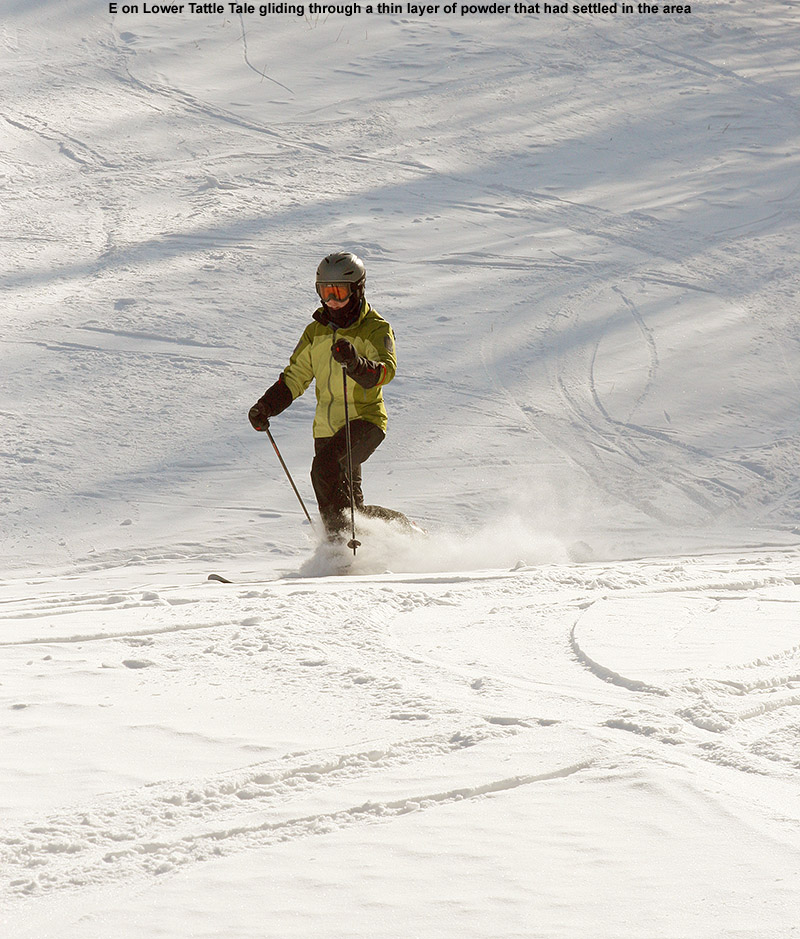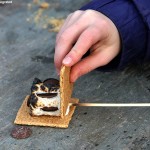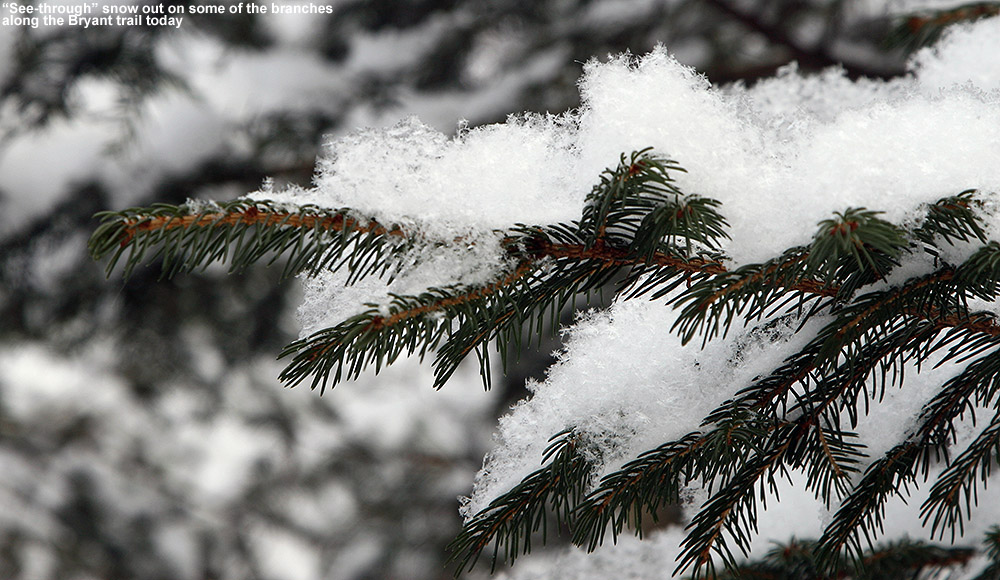
We’re currently in the midst of what could be one of our largest snowstorms of the season here in Northern Vermont, with multiple feet of snow possible for the higher elevations along the spine of the Greens. Earlier this week, the mountains already picked up about a foot of snow from the combination of two storms, one on Tuesday/Wednesday, and another on Thursday, so a substantial dump from this storm will really have conditions going off. The current storm actually started up in this area midday yesterday, and I saw a fresh inch of snow on the ground in Burlington when I left around 4:00 P.M. We’d received up a couple of inches of snow at the house as of 6:00 P.M., and thanks to inch an hour snowfall, we picked up another quick couple of inches through 8:00 P.M. before the precipitation tapered off overnight.
This morning, temperatures were around the freezing mark down in the valley, and little snow was actually falling at our house, but the mountains were getting pounded with upslope flakes. Powderfreak sent in a report to Americanwx.com this morning indicating that it was a total whiteout at Stowe Mountain Resort. So much snow had fallen overnight that snowmobiles and even snowcats were having difficulty getting up the mountain. The upslope power of the Northern Greens was in full effect.

Not surprisingly, heavy snowfall was hitting Bolton Valley as well, but high winds meant that all the chairlifts were on wind hold at the resort, and employees were stationed at the bottom of the Bolton Valley Access Road to save people the hassle of driving up if they didn’t know about the weather delays. We’d all brought our Telemark skis and skins and were planning to earn turns as needed, so when we reached the bottom of the access road we let the employees know that we’d be earning turns and they waved us through. Having old tires with minimal tread, even the Subaru struggled to get up the steep S-curve on the access road this morning, and a big part of that was because the snow was falling so quickly that the plows couldn’t really keep up. Fortunately, we were able to get up to the Village safely. The snow was indeed falling very heavily up above 2,000’ in the Village; I’d estimate that was coming down in the range of 1 to 3 inches per hour.

Dylan had to use the restroom right when we arrived in the Village, so E and the boys headed up to the base lodge quickly with some of the Telemark gear, while I finished suiting up and got the rest of the gear together. Just as I was about to head up to the lodge as well, I got a call from E that the Mid Mountain Lift was running, so I grabbed the boys’ alpine gear for them to use. It was quite a load with three pairs of skis, two pairs of poles, and a couple sets of boots, but I managed to get everything up to the lodge, and indeed the Mid Mountain Lift was humming along serving at least a little vertical to happy skiers and riders.
Dylan’s stomach was bothering him a bit, so E hung out inside with him while Ty and I headed out for a few Mid Mountain runs. Outside the lodge at the ski racks, we met up with Jason, who had just come down from Wilderness with another one of the instructors. He said there was indeed a lot of snow up there in the higher elevations – enough that you wanted to stick to terrain with good pitch if possible. The wind was also strong, so that was having an effect on the distribution of the snow. Heading to the upper mountain would have been my plan as well, but it’s still a lot of work for the boys at this stage, so sticking to lift-served terrain on the bottom half of the mountain was the way to go. We’re already very excited about how far the boys have come in terms of ascending for skiing, but it’s going to be fun to see what things are like as their skills and stamina continue to increase.

Ty suggested Enchanted Forest for our first run off Mid Mountain, and the snow was excellent, but only the steepest spots were really good for skiing in the deep powder, so we headed back to Beech Seal to finish off the run. Acknowledging the need for steeper pitches, I took Ty over to the Butterscotch Terrain Park via Deer Run. We did get some nice turns in the park on the steep pitches on the back side of the features, but some of the best turns were actually on that steep pitch where Deer Run drops down to Sprig O’ Pine. Unfortunately I didn’t get any photos there, but I pulled out the camera and got some nice shots of Ty skiing of the terrain park features amidst the very heavy snowfall.
The intense snowfall from the storm was lots of fun to witness, but the strong winds that came with it were much less enjoyable. The winds were from the west/northwest, so riding the chair was no problem, but they really bit into you when you headed down the west-facing runs. Thus it wasn’t too long before Ty and I were ready for a lunch break. Dylan had actually fallen asleep while we’d been outside, but he woke up once we were back inside; he was feeling much better and was ready for lunch. We headed upstairs and had lunch near the Fireside Flatbread area; crowds were pretty minimal with so many people being turned back at the base of the access road, so it was very quiet up there.

The four of us headed back out for a few more runs after lunch, starting with a run down Glades since Ty and I hadn’t checked it out earlier. The steeper terrain at the top was sufficient for some decent powder skiing, although that meant that it was getting plenty of traffic, so fresh tracks were a little harder to come by. We also checked out Beech Seal, since it’s got reasonably steep terrain at the top. It was also fine for turns, but it’s pretty exposed to the west wind and that took away from the experience. It continued to snow, so it was hard to pull away from the slopes, but the wind was unabated and we eventually decided it was time to take off the skis and save some energy for tomorrow, which looks like it’s going to be a memorable one. We had also promised the boys that they could do some swimming at the sports center after they skied, so they were anxious to get down to the pool.

The pool at the sports center was hopping with many visitors that had decided to stay inside out of the storm, and while E and the boys swam, I took the opportunity to tour around the Village and get some photographs of the snow. I got some great images of where the fluffy Champlain Powder™ had accumulated with fantastic loft in sheltered locations such as on the leeward side of the Courtside 2 Condos, and in other spots I got some cool shots of the dramatic drifting caused by the wind. I found cars in the parking lots that sat through the whole storm and had virtually disappeared beneath the snow. Even in some of those drifted areas though, the snow often managed to retain incredible loft. One could walk through some waist or chest deep drifted areas where the snow would simply dissolve around you as you went through it. The snow was actually letting up for a time while I toured around the Village, and there were some points where it almost appeared as though the storm was over, but it always seemed to make a resurgence. The breaks in the blizzard-like conditions certainly helped with the photography though.

At the end of the afternoon, our descent of the access road was much easier than the ascent had been; the snow wasn’t falling quite as hard, so presumably the plows could keep pace. When we’d left the house earlier in the day, it wasn’t really snowing, so we were very curious to see if anything had gone on down in the valley while we were away. That question was answered pretty quickly when we found that the snow in the driveway was now a foot deep, and 7.1 inches of new snow had accumulated on the snowboard while we were at the mountain. I took a core sample from atop the snowboard and the snow came in at a density of 3.8% H2O. But the storm isn’t done delivering Champlain Powder™ just yet; through 10:30 P.M. this evening we picked up an additional 8.4 inches of 2.1% H2O powder, and it’s still going. We’ve now received over 20 inches from this storm down here in the valley, and the mountains will likely double that amount; it looks like tomorrow at Stowe is going to be simply off the hook!















































































































